A Closer Look:
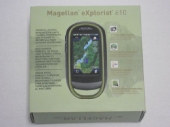 |
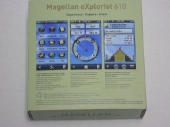 |
The box for the eXplorist 610 features some nice earthy colors, sticking with the outdoors theme. On the back we see some sample images of the menu interface. We found the user interface to not be overly complicated to navigate. It may take a little while to figure out where everything is located if you’re not used to other Magellan interfaces, but overall things are laid out logically.
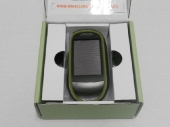 |
Inside the box, in addition to the quick start guide, you will find a 1-month premium membership trial to geocaching.com. This will give you the best experience when trying to use the eXplorist 610 for geocaching.
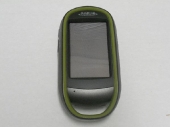 |
 |
The casing of the 610 is made of plastic and rubber. The build quality feels solid without being bulky. The loop at the bottom of the unit makes it easy to use a clamp to attach it to your hiking pack or belt. The touch screen is resistive, so it’s not as accurate as a capacitive touch screen, but the on screen buttons are large enough that it usually isn’t an issue. The camera is 3.2 MP and the quality is similar to that of a cell phone camera.
In Field Testing:
It’s all good and fun to rattle off specs about a device, but it doesn’t compare to using it in the field. In my spare time I like to geocache. I wouldn’t call myself a professional (some cachers have over 2000 finds), but I’m not inexperienced (I have over 100 finds to my name). Myself and a few friends planned a day trip to find a basic cache and multi-part puzzle cache. The final test was a 4/5 (difficulty/terrain on a scale of 1 to 5) night cache. Loading GPX files on to the eXplorist 610 was very easy. When connected, the device shows up just like a USB drive. It’s just a simple matter of copying the GPX file to the “Geocaches” folder. While the device does come preloaded with 1000 geocaches, you will probably want to search for some more in your immediate area, as caches are always being added and updated.
Normally I use my phone when geocaching (a Motorola Droid). The GPS receiver is good on it and it allows me to search for geocaches on the go and easily pull up logs and descriptions. This is one advantage that using a phone will always have, instant access.
First Cache: Traditional (GC1EVVB)
I had found this cache before, so I knew where the coordinates should point to. The eXplorist led me right to where it traditionally is hidden. When I arrived at the location, I found that the cache had been moved from its normal position (not an uncommon thing in the geocaching world). I used this opportunity to let my buddy Rob hone his “geo senses” and try to find it on his own. Eventually he was able to find it and log his first find of the day.
| Rob with his first find (Picture was taken using the camera on the eXplorist 610, click for full size resolution.) |
Second Cache: Multi-Part Puzzle Cache (GC1JYY1)
I had also found this cache before, but the owner had updated some of the clues since the last time I found it. The nature of this cache involves going to various locations and gathering some piece of information that will help you solve the final coordinates where the cache is located. The tree cover can sometimes make it difficult to acquire an accurate reading, but the eXplorist 610 handled it like a champ.
| Rob and me after solving the puzzle (Picture was taken using the camera on the eXplorist 610, click for full size resolution.) |
Final Cache: Puzzle Night Cache
I’m not posting the GC code for this cache, as the images and description would likely ruin part of the fun of this puzzle cache for anyone that wanted to attempt it. The cache requires that your GPS have a track log to see where you’ve been. Fortunately the eXplorist 610 has this feature. But before you can find the cache, you have to bushwhack through over a mile of dense forest and swamp land, following reflectors that lead you along the path. In the picture below you can see the result of me wading through nearly knee deep swamp water as I pass by one of the trail reflectors. In the second image we see the result of getting half way through the trail. The GPS begins to draw out an arrow to where the cache is supposed to be located. Luckily we had enough sense to realize the image that was being drawn, before we got to the part that we knew had chest deep water (from reading other people’s logs and the cache description).
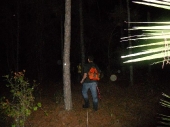 |
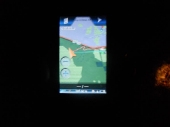 |
In the end we were able to find the cache and sign the log. The eXplorist 610 “pointed” us to where we needed to go and was able to survive the brief encounter with swamp water that it had.
We were able to grab all of the caches on a single set of batteries. The only way you will be able to come close to achieving the 16 hours of battery life that Magellan advertises, is if you use some high power lithium ion batteries. The power draw is too high for your dollar store batteries (it won’t even function properly if you try).
Conclusion:
By the end of our testing, the eXplorist 610 was able to handle the gauntlet we put it through. We used it to find several geocaches, and it even survived a brief bout with swamp water. The cost of $449.99 may seem a bit prohibitive at first, but it is in line with other GPSs on the market. Even if you’re not into geocaching, there is still a lot of functionality that is geared towards general outdoor activity. At the end of the day, the product works as advertised and will make a great addition for your next outdoor excursion.




[…] eXplorist 610 GPS. Find out it it has what it takes to guide you in your next outdoor adventure.http://www.techwarelabs.com/magellan-explorist-610-gpsDiggLeave a Reply Click here to cancel reply. Name (required) Mail (will not be published) […]
Magellan eXplorist 610 GPS | TechwareLabs…
Here at World Spinner we are debating the same thing……